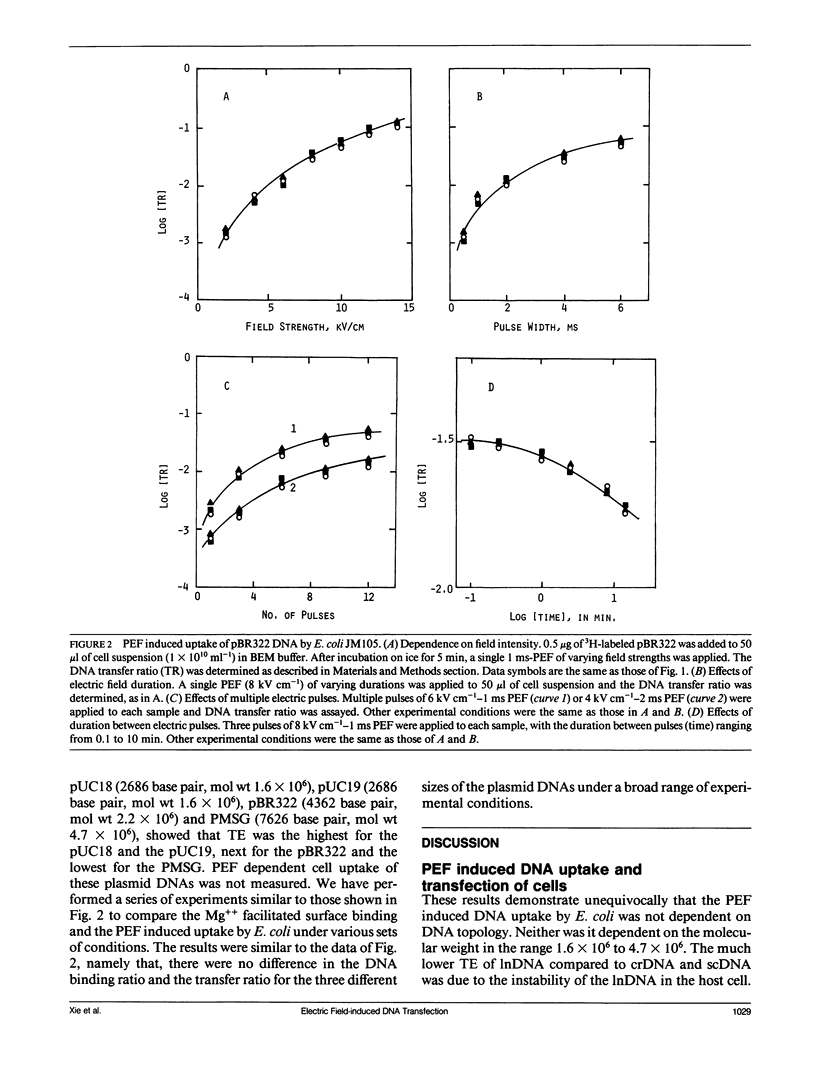Abstract
Electric parameters and solvent conditions are known to influence the efficiency of DNA transfection of cells by a pulsed electric field (PEF). A previous study (Neumann, E., M. Schaefer-Ridder, Y. Wang, and P. H. Hofschneider. 1982. EMBO (Eur. Mol. Biol. Organ.) J. 1:841-845) has indicated that DNA topology is also an important determinant. We report an investigation of the PEF induced uptake, stability, and expression of three different topological isomers, circular supercoiled (scDNA), circular relaxed (crDNA), and linearized (lnDNA) forms of the plasmid pBR322, by Escherichia coli strain JM105. Monomeric pBR322 prepared by the electroelution from an agarose gel was in the supercoiled form. Treatment of the scDNA with wheat germ topoisomerase I removed the superhelicity and the DNA assumed the relaxed circular form. Treatment of scDNA by a restriction endonuclease, EcoRI or Hind III, linearized the DNA. The MgCl2-dependent bindings of all three forms of DNA to the cell surface were indistinguishable. So was the PEF induced cell uptake. In contrast, the transfection efficiency (TE) for the scDNA and the crDNA were high (approximately 2 x 10(8) micrograms-1 DNA at neutral pH), whereas that for the lnDNA was approximately five orders of magnitude lower (less than 1 x 10(3) micrograms-1 DNA). Analysis by agarose gel electrophoresis indicated that the PEF loaded ln DNA was degraded by the host cell within 3 h. However, the loaded scDNA and the crDNA were stable and expressed in the cytoplasm. We conclude that first, the PEF induced DNA entry into E. coli did not depend on the topology of the DNA. As cellular uptake of DNA also correlated with the surface binding, these data support electrophoresis of surface bound DNA as the dominating mechanism for the DNA entry. Second, the variations of TE for different topological forms of DNA reflected their relative stability in the host cells. Third, since the loaded DNA could be either rapidly degraded by the host enzyme or expressed, they were unlikely coated with a layer of protective lipid membrane. Thus, PEF induced cellular uptake of DNA is unlikely by the endocytotic mechanisms as was reported previously for the liposomes (Chernomordik, L. V., A. V. Sokolov, and V. G. Budker. 1990.Biochim. Biophys. Acta. 1024:179-183).
Full text
PDF





Images in this article
Selected References
These references are in PubMed. This may not be the complete list of references from this article.
- Chang D. C. Cell poration and cell fusion using an oscillating electric field. Biophys J. 1989 Oct;56(4):641–652. doi: 10.1016/S0006-3495(89)82711-0. [DOI] [PMC free article] [PubMed] [Google Scholar]
- Chernomordik L. V., Sokolov A. V., Budker V. G. Electrostimulated uptake of DNA by liposomes. Biochim Biophys Acta. 1990 May 9;1024(1):179–183. doi: 10.1016/0005-2736(90)90222-a. [DOI] [PubMed] [Google Scholar]
- Dimitrov D. S., Sowers A. E. Membrane electroporation--fast molecular exchange by electroosmosis. Biochim Biophys Acta. 1990 Mar;1022(3):381–392. doi: 10.1016/0005-2736(90)90289-z. [DOI] [PubMed] [Google Scholar]
- Felgner P. L., Rhodes G. Gene therapeutics. Nature. 1991 Jan 24;349(6307):351–352. doi: 10.1038/349351a0. [DOI] [PubMed] [Google Scholar]
- Klenchin V. A., Sukharev S. I., Serov S. M., Chernomordik L. V., Chizmadzhev YuA Electrically induced DNA uptake by cells is a fast process involving DNA electrophoresis. Biophys J. 1991 Oct;60(4):804–811. doi: 10.1016/S0006-3495(91)82115-4. [DOI] [PMC free article] [PubMed] [Google Scholar]
- Neumann E., Schaefer-Ridder M., Wang Y., Hofschneider P. H. Gene transfer into mouse lyoma cells by electroporation in high electric fields. EMBO J. 1982;1(7):841–845. doi: 10.1002/j.1460-2075.1982.tb01257.x. [DOI] [PMC free article] [PubMed] [Google Scholar]
- Potter H. Electroporation in biology: methods, applications, and instrumentation. Anal Biochem. 1988 Nov 1;174(2):361–373. doi: 10.1016/0003-2697(88)90035-8. [DOI] [PubMed] [Google Scholar]
- Sowers A. E. Fusion events and nonfusion contents mixing events induced in erythrocyte ghosts by an electric pulse. Biophys J. 1988 Oct;54(4):619–626. doi: 10.1016/S0006-3495(88)82997-7. [DOI] [PMC free article] [PubMed] [Google Scholar]
- Tekle E., Astumian R. D., Chock P. B. Electroporation by using bipolar oscillating electric field: an improved method for DNA transfection of NIH 3T3 cells. Proc Natl Acad Sci U S A. 1991 May 15;88(10):4230–4234. doi: 10.1073/pnas.88.10.4230. [DOI] [PMC free article] [PubMed] [Google Scholar]
- Titomirov A. V., Sukharev S., Kistanova E. In vivo electroporation and stable transformation of skin cells of newborn mice by plasmid DNA. Biochim Biophys Acta. 1991 Jan 17;1088(1):131–134. doi: 10.1016/0167-4781(91)90162-f. [DOI] [PubMed] [Google Scholar]
- Toneguzzo F., Keating A. Stable expression of selectable genes introduced into human hematopoietic stem cells by electric field-mediated DNA transfer. Proc Natl Acad Sci U S A. 1986 May;83(10):3496–3499. doi: 10.1073/pnas.83.10.3496. [DOI] [PMC free article] [PubMed] [Google Scholar]
- Tsong T. Y. Electrical modulation of membrane proteins: enforced conformational oscillations and biological energy and signal transductions. Annu Rev Biophys Biophys Chem. 1990;19:83–106. doi: 10.1146/annurev.bb.19.060190.000503. [DOI] [PubMed] [Google Scholar]
- Tsong T. Y. Electroporation of cell membranes. Biophys J. 1991 Aug;60(2):297–306. doi: 10.1016/S0006-3495(91)82054-9. [DOI] [PMC free article] [PubMed] [Google Scholar]
- Wong T. K., Neumann E. Electric field mediated gene transfer. Biochem Biophys Res Commun. 1982 Jul 30;107(2):584–587. doi: 10.1016/0006-291x(82)91531-5. [DOI] [PubMed] [Google Scholar]
- Xie T. D., Sun L., Tsong T. Y. Study of mechanisms of electric field-induced DNA transfection. I. DNA entry by surface binding and diffusion through membrane pores. Biophys J. 1990 Jul;58(1):13–19. doi: 10.1016/S0006-3495(90)82349-3. [DOI] [PMC free article] [PubMed] [Google Scholar]
- Xie T. D., Tsong T. Y. Study of mechanisms of electric field-induced DNA transfection. II. Transfection by low-amplitude, low-frequency alternating electric fields. Biophys J. 1990 Oct;58(4):897–903. doi: 10.1016/S0006-3495(90)82434-6. [DOI] [PMC free article] [PubMed] [Google Scholar]



